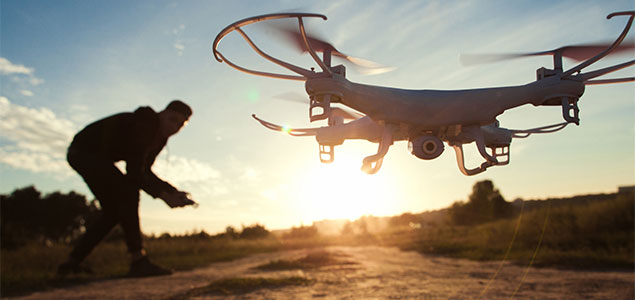By Katrina Olson
Camera-equipped drones are the marketer’s hottest new toy. Distributors and manufacturers are using it to showcase their outdoor lighting projects, warehouses, and building exteriors. Drone video is new and engaging, and can help you stand out in the crowd. Aerial video can help tell your story from another perspective, literally.
How to Get Started with Drone (or any) Video
- Whether you own a drone or you’re renting one, before you start shooting, know these four things: your goal, intended audience, primary message and intended outcome. Download this free “Communication Brief” template with 21 questions you should ask before starting any marketing effort:
- Now you have a strategy and you’re ready to start shooting, right? Before you begin, write a script. Here’s a guide and free template:
- Consider making a shot list that includes key shots and b-roll or “background video.”
- Next, create a storyboard showing what shots go with what copy. Here are some free tools:
- Free storyboard template for film and video projects
- Storyboard templates (simpler versions)
Follow These Video Production and Editing Guidelines
Video production is a learned skill, just like writing, graphic design or web design. But if you’re doing it yourself, here are some tips:
- Use wide shots to show the setting — called an “establishing shot.”
- Change visuals to move the story along and indicate a new scene or segment.
- Purchase royalty-free stock music to add depth and texture.
- Add narration to tell your story and drive home your message.
- For visual interest, use a variety of aerial shots, long shots, medium shots and close-ups.
- Use b-roll to illustrate concepts or ideas during narration.
- Assemble a series of shots to show a process or progression of the story.
- Capture natural ambient sounds or use an “ambience” sound effects track for realism.
- Use a combination of cuts (e.g. match cuts and cutaways) and try to avoid jump cuts.
- Use transitions (e.g. fade, dissolve, wipe, freeze) depending on your purpose. For example, a fade signifies a beginning or end, a transition between scenes, or a major change in time or location.
- Position superimposed words (supers) carefully to create contrast for readability, and don’t cover important action, people or images.
Sound like a lot to remember? It is. And this is only a cursory review. If you’re not comfortable learning as you go, consult with a professional videographer, production company, consultant or agency.
 Make the Most of Drone Technology
Make the Most of Drone Technology
In 2015, Eaton used drone video to demonstrate how they retrofitted the eight-acre Harshaw-Trane campus in Louisville with LED lighting to eliminate blind spots and save energy. Watch it below:
Drone footage can also:
- Show the massive size and scope of something
- Capture events or motion-related competitions or activities
- Track the progress of large-scale construction or renovation projects from multiple angles
- Get a birds-eye view of outdoor lighting to demonstrate inefficiencies for potential customers.
- Document a large-scale lighting installation in a building, outdoor venue or parking lot.
Thanks to social media and dwindling attention spans, video is hotter than ever. And let’s admit it—drones are cool. But drone video is the medium, not the message. Video of any kind works best when it’s one of several tactics—part of an integrated, multimedia campaign or plan with clear goals, objectives and strategies.
—
Olson is a marketing and public relations consultant, and principal of Katrina Olson Strategic Communications. She has written for tED magazine’s print edition since 2005, judged tED magazine’s Best of the Best Competition since 2006, and emceed the Best of the Best Awards ceremony for a total of seven years. She can be reached at Katrina@katrinaolson.comor via her website at katrinaolson.com.
Tagged with Exclusive Feature, lighting, marketing, tED






